Jones M., Fleming S.A. Organic Chemistry
Подождите немного. Документ загружается.

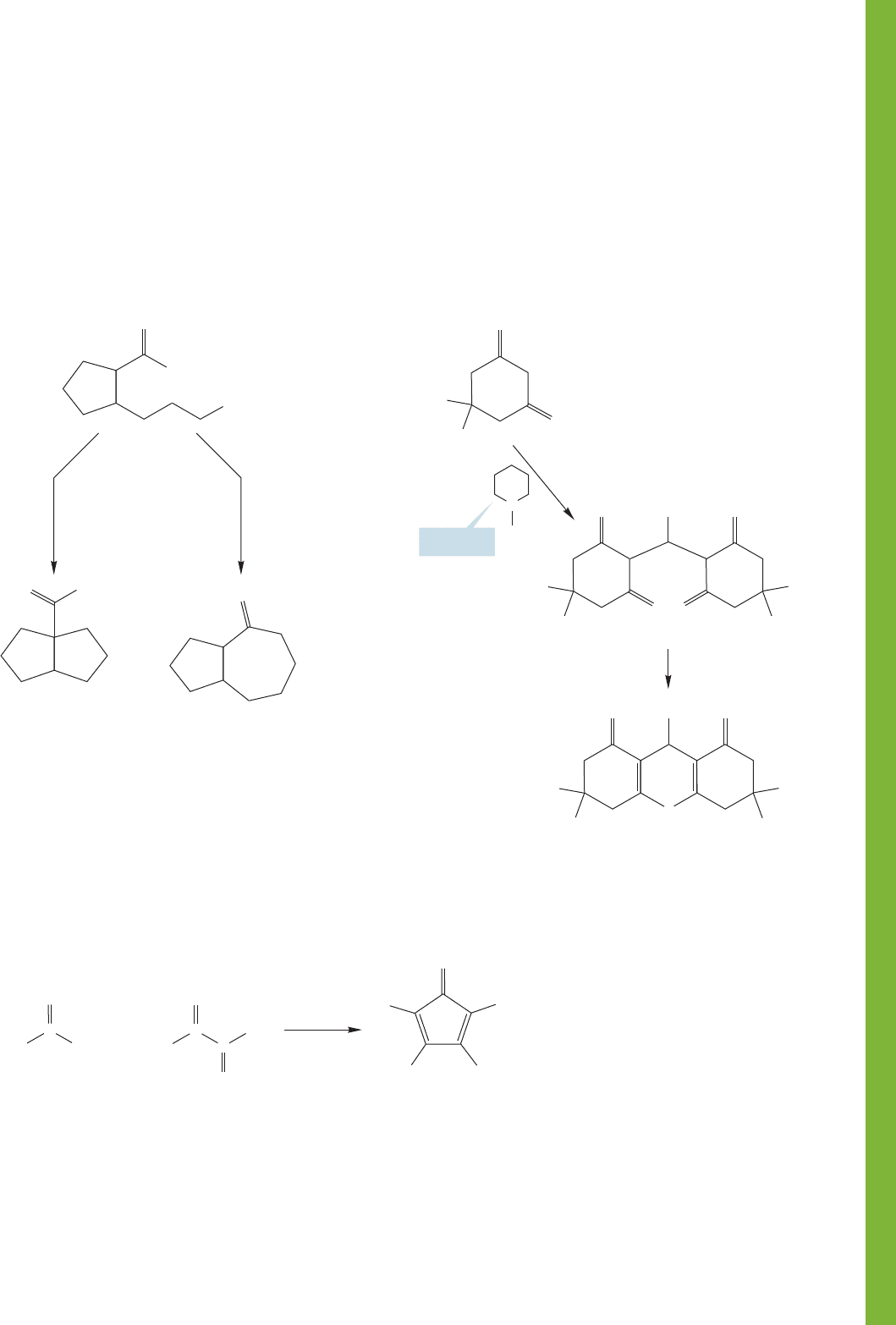
19.17 Additional Problems 1019
1
2
3
1. (CH
3
)
3
COK,
(CH
3
)
3
COH, 25 ⬚C
2. H
2
O
3. H
2
O
1. LDA/THF, –72 ⬚C
2.
O
O
CH
3
CH
3
Br
O
PhH
2
C
C
CH
2
Ph
O
Ph
C
C
12 3
Ph
KOH
CH
3
CH
2
OH
O
O
O
+
Ph
Ph
PhPh
PROBLEM 19.59 When bromo ketone 1 is treated with
potassium tert-butoxide in tert-butyl alcohol at room tempera-
ture, it gives exclusively the 5,5-fused bicyclic ketone 2.In
contrast, when 1 is treated with LDA in tetrahydrofuran (THF)
at 72 °C, followed by heating, the product is predominately
the 5,7-fused ketone 3. Write arrow formalism mechanisms for
these cycloalkylation reactions and explain why the different
reaction conditions favor different products.
PROBLEM 19.60 Condensation of 1,3-diphenylacetone (1)
and benzil (2) in the presence of alcoholic potassium hydrox-
ide affords tetraphenylcyclopentadienone (3), a dark purple
solid. Write an arrow formalism mechanism for the formation
of 3.
PROBLEM 19.61 Aldehydes, but not ketones, readily react
with 5,5-dimethyl-1,3-cyclohexanedione (dimedone, 1) in the
presence of a base (such as piperidine) to give crystalline dime-
done derivatives, 2. These compounds can be converted into
octahydroxanthenes, 3, upon heating in ethyl alcohol with a
trace of acid. Provide arrow formalism mechanisms for the for-
mation of 2 from 1 and an aldehyde (RCHO), as well as for the
conversion of 2 into 3.
1
H
2
O/EtOH/
+ RCHO
H
3
O
+
O
O
H
3
C
H
3
C
2
OOR
O
O
H
3
C
H
3
C
N
H
CH
3
CH
3
3
OR
H
3
C
H
3
C
CH
3
CH
3
O
O
Piperidine
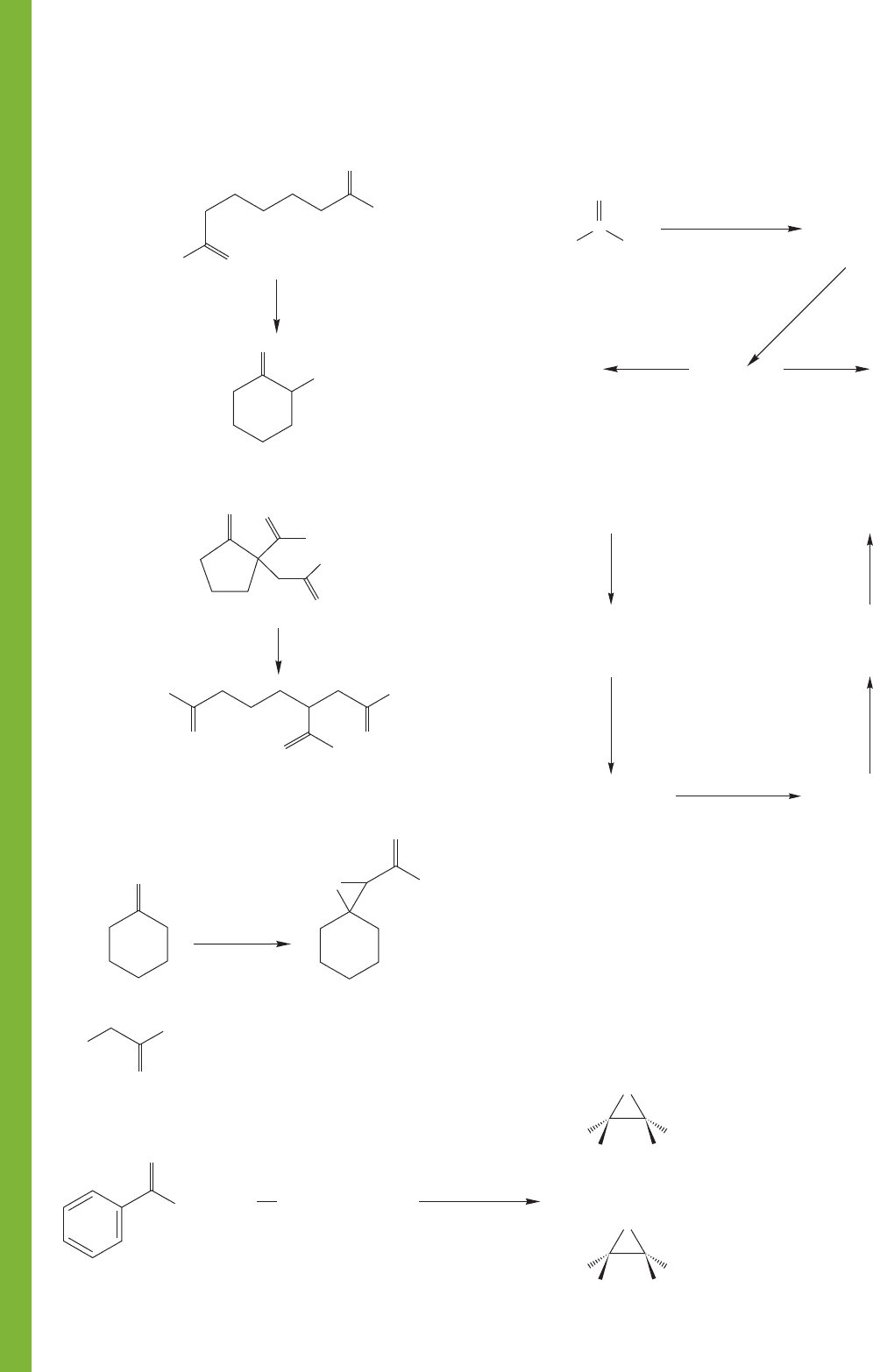
1020 CHAPTER 19 Carbonyl Chemistry 2: Reactions at the Position␣
PROBLEM 19.62 Write a mechanism for the following
Dieckmann condensation:
H
3
CO
1. NaOCH
3
(full equiv.)
HOCH
3
2. CH
3
COOH
O
O
O
COOCH
3
OCH
3
PROBLEM 19.63 Here is a reverse Dieckmann condensation.
Write a mechanism for it.
NaOCH
3
HOCH
3
O
O
O
O O
OCH
3
CH
3
O
OCH
3
OCH
3
OCH
3
O
PROBLEM 19.64 Write an arrow formalism mechanism for the
following reaction (the Darzens condensation):
O
(89%)
OCH
2
CH
3
OCH
2
CH
3
(CH
3
)
3
COK
(CH
3
)
3
COH
10 ⬚C, 1.5 h
O
O
O
+
Cl
O
Cl
+
CH
2
COOCH
2
CH
3
COOCH
2
CH
3
Ph
Ph
CH
3
–
OC(CH
3
)
3
K
+
HOC(CH
3
)
3
H
O
COOCH
2
CH
3
CH
3
H
3
C
H
O
+
PROBLEM 19.65 Account for the formation of both
stereoisomers in the Darzens condensation shown below:
PROBLEM 19.66 Provide structures for intermediates A–D.
Mechanisms are not necessary.
(C
6
H
12
S
2
)
A
H
3
O
+
(C
10
H
12
O)
C
(C
10
H
14
)
D
(C
13
H
18
S
2
)
B
H
2
O
HBF
4
HgO
Raney Ni
1. BuLi
2. PhCH
2
Br
C
O
CH
3
CH
2
HSCH
2
CH
2
CH
2
SH
H
PROBLEM 19.67 Provide structures for compounds A–D.
Mechanisms are not required.
CH
3
OH
A
(C
4
H
8
O
2
)
B
(C
7
H
12
O
3
)
C
(C
8
H
14
O
3
)
D
(C
6
H
12
O)
Propanoic acid 2-Methylpentane
H
3
O
1. NaOCH
3
(1 equiv.)
CH
3
OH
1. NaOCH
3
HOCH
3
NH
2
NH
2
KOH
Δ
2. CH
3
I
2. H
2
O/H
3
O
+
H
2
O/H
3
O
+
+

19.17 Additional Problems 1021
PROBLEM 19.69
Now here is a pair of slightly more
complicated Knoevenagel reactions. Provide arrow formalism
mechanisms.
PROBLEM 19.68 Here is a pair of relatively simple
Knoevenagel condensations. Write arrow formalism mecha-
nisms for the following conversions:
(79%)
(81%)
(CH
3
)
3
COK
1. NaOH/H
2
O
CH
3
OH
2. HCl
CH
3
NO
2
(CH
3
)
3
COH
C
N
CHO
N
H
H
Ph
O
(a)
(b)
CH
3
+
CC
Ph
H
H
H
NO
2
H
3
C
C
H
O
(a)
(b)
H
3
CCH
2
OCH
2
CH
3
C
O
C
O
+
CH
3
CH
2
C
H
O
OCH
2
CH
3
NCCH
2
C
O
+
CH
3
CH
2
OH
0 ⬚C
CH
3
COOH
H
2
/Pd
(>50%)
H
3
C
H
3
C
H
3
C
CH
CH
H
OCH
2
CH
3
OCH
2
CH
3
C
C
O
O
C
O
C
C
O
CN
COOCH
2
CH
3
N
H
N
H
PROBLEM 19.70 Provide structures for compounds A–E.
Mechanisms not required.
1. O
3
A
(C
3
H
4
O
4
)
B
(C
5
H
8
O
4
)
C
(C
9
H
16
O
4
)
D
(C
7
H
12
O
4
)
E
(C
6
H
12
O
2
)
2. HOOH
CH
3
OH
1. NaOCH
3
HOCH
3
100 °C
2. CH
3
CH
2
CH
2
CH
2
I
H
3
O
+
H
2
O
H
3
O
+
O
O
NaOH
CH
3
CH
2
OH/H
2
O
1
2
H
3
C
CH
2
CH
3
O
CH
3
CH
2
CH
3
PROBLEM 19.71 Write an arrow formalism mechanism for the
conversion of diketone 1 into the important perfumery ingredi-
ent cis-jasmone (2). There is another possible cyclopentenone
that could be formed from 1. What is its structure? Write an
arrow formalism mechanism for its formation.
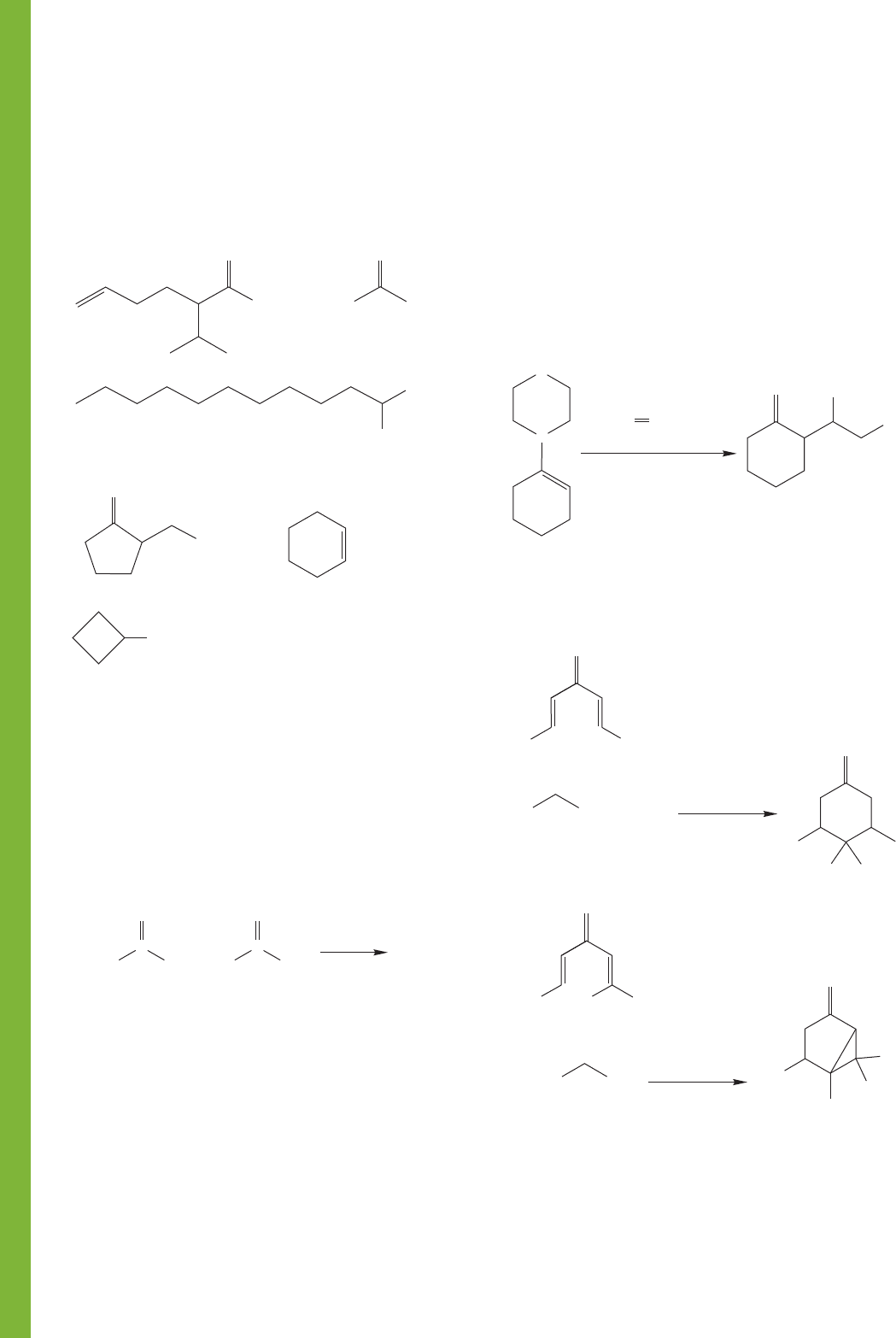
1022 CHAPTER 19 Carbonyl Chemistry 2: Reactions at the Position␣
(a)
(b)
(c)
(d)
from
from
from
O
O
CH
3
Ph
COOH from CH
2
(COOCH
3
)
2
and BrCH
2
CH
2
CH
2
Cl
COOH
CH
3
OCH
2
CH
3
CH
2
(COOCH
3
)
2
H
3
C
O
NaOH
1
2
H
3
C
H
2
O
CH
3
C
H
Ph
O
C
O
++
PROBLEM 19.73 When benzaldehyde and an excess of acetone
react in the presence of aqueous sodium hydroxide, compound 1
is obtained as the major product as well as a small amount of
compound 2. However, when acetone and an excess (at least 2
equiv.) of benzaldehyde react under the same conditions, the
predominant product is compound 2. Spectral data for com-
pounds 1 and 2 are summarized below. Deduce structures for
compounds 1 and 2 and rationalize their formation.
2. H
2
O/H
3
O
+
1. PhCH CHNO
2
(2)
CH
3
CN
N
O
1
3
Ph
O
NO
2
PROBLEM 19.72 Propose syntheses for the following target
molecules starting from the indicated material. You may use any
other reagents that you need. Mechanisms are not required. Use
a retrosynthetic analysis in each case.
Compound 1
Mass spectrum: m/z 146 (p, 75%), 145 (50%),
131 (100%), 103 (80%)
IR (Nujol): 1667 (s), 973 (s), 747 (s), 689 (s) cm
1
1
H NMR (CDCl
3
): 2.38 (s 3H), 6.71 (d, J 16 Hz, 1H),
7.30–7.66 (m, 5H), 7.54 (d, J 16 Hz, 1H)
PROBLEM 19.75 Provide mechanisms for the following
changes. Hint: Definitely do (a) before (b).
+
(a)
O
O
Ph
Ph
NC COOCH
2
CH
3
Ph
Ph
CN
CH
3
CH
2
OOC
+
(b)
O
O
NC
OTs
NaOCH
2
CH
3
HOCH
2
CH
3
NaOCH
2
CH
3
HOCH
2
CH
3
H
3
C
H
3
C
H
3
C
CH
3
CN
CH
3
CH
3
Compound 2
Mass spectrum: m/z 234 (p, 49%), 233 (44%), 131 (42%),
128 (26%), 103 (90%), 91 (32%), 77 (100%), 51 (49%)
IR (melt): 1651 (s), 984 (s), 762 (s), 670 (s) cm
1
1
H NMR (CDCl
3
): 7.10 (d, J 16 Hz, 1H), 7.30–7.70
(m, 5H), 7.78 (d, J 16 Hz, 1H)
PROBLEM 19.74 Reaction of 1-morpholinocyclohexene
(1) and β-nitrostyrene (2), followed by hydrolysis, yields the
nitro ketone 3. Write an arrow formalism mechanism for
this reaction sequence and be sure to explain the observed
regiochemistry.
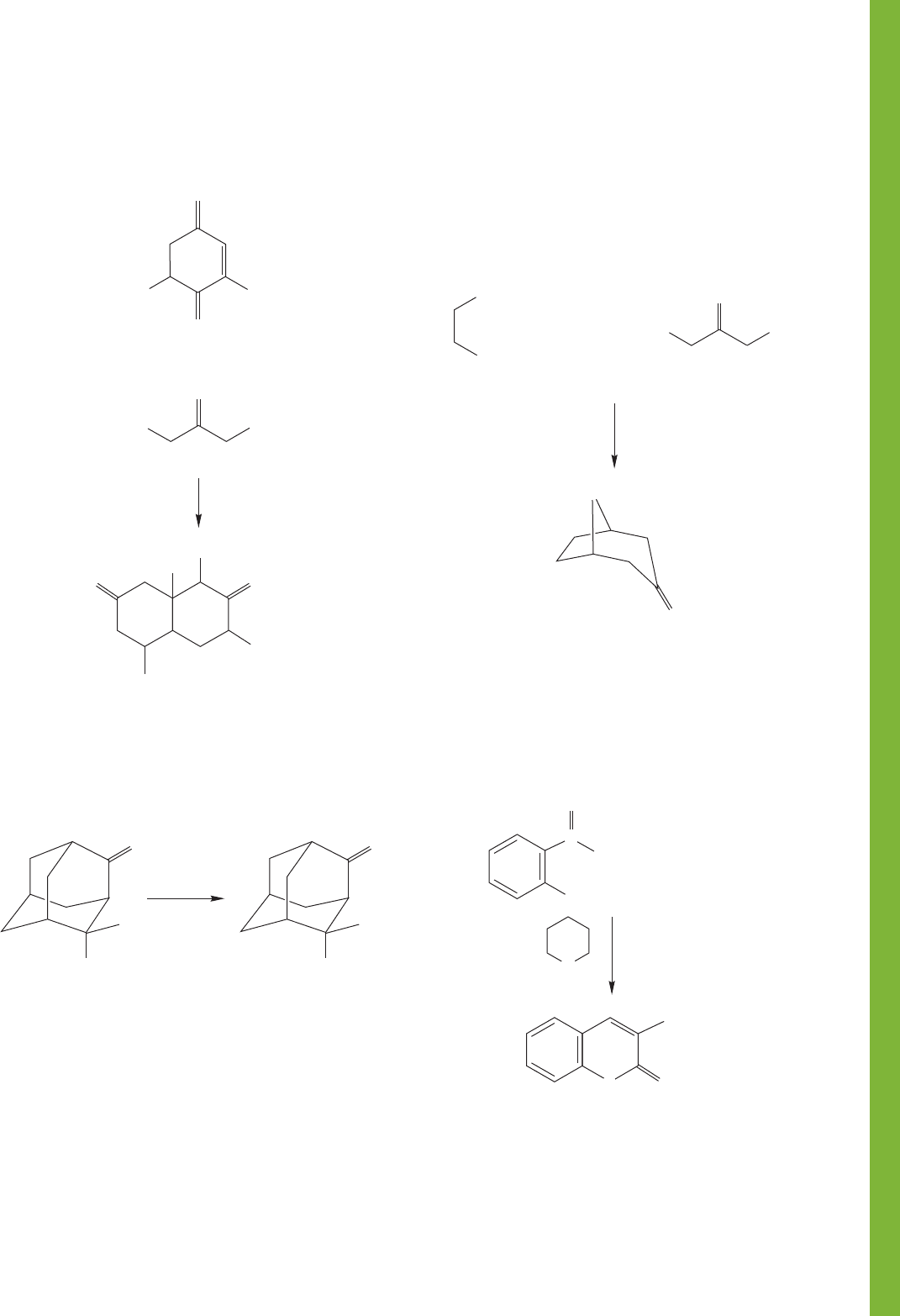
19.17 Additional Problems 1023
PROBLEM 19.76
Write a mechanism for the following
transformation:
O
H
3
CCH
3
NaOCH
2
CH
3
HOCH
2
CH
3
COOCH
2
CH
3
CH
3
H
3
C
O
+
CH
3
CH
2
OOC COOCH
2
CH
3
COOCH
2
CH
3
O
O
CH
2
PROBLEM 19.77 Explain the striking observation that
methylation of the alcohol 1 leads to a methoxy compound
in which the stereochemistry of the oxygen has changed.
Hint : Note that 1 is a β-keto alcohol.
1. NaH
2. CH
3
I
1
OH
O
OCH
3
H
O
H
PROBLEM 19.78 In 1917, Robinson reported a synthesis
(called “von bewundernswerter Eleganz” by the German
chemist Willstätter) of tropinone (3) involving the condensa-
tion of succindialdehyde (1), methylamine, and 1,3-acetone
H
2
O
CH
3
NH
2
3
2
1
25 ⬚C
CHO
CHO
++
HOOC COOH
O
O
CH
3
N
PROBLEM 19.79 Provide an arrow formalism mechanism for
the following reaction:
+
CH
2
(COOCH
2
CH
3
)
2
COOCH
2
CH
3
H
H
OH
C
O
N
CH
3
CH
2
OH, Δ
O
O
dicarboxylic acid (2). Schöpf subsequently improved the yield of
this reaction to about 90%. Propose a plausible mechanism for
this reaction. Hints: This reaction involves a double condensa-
tion of some kind. Acetone can be used in place of 2, although
the yield is reduced.
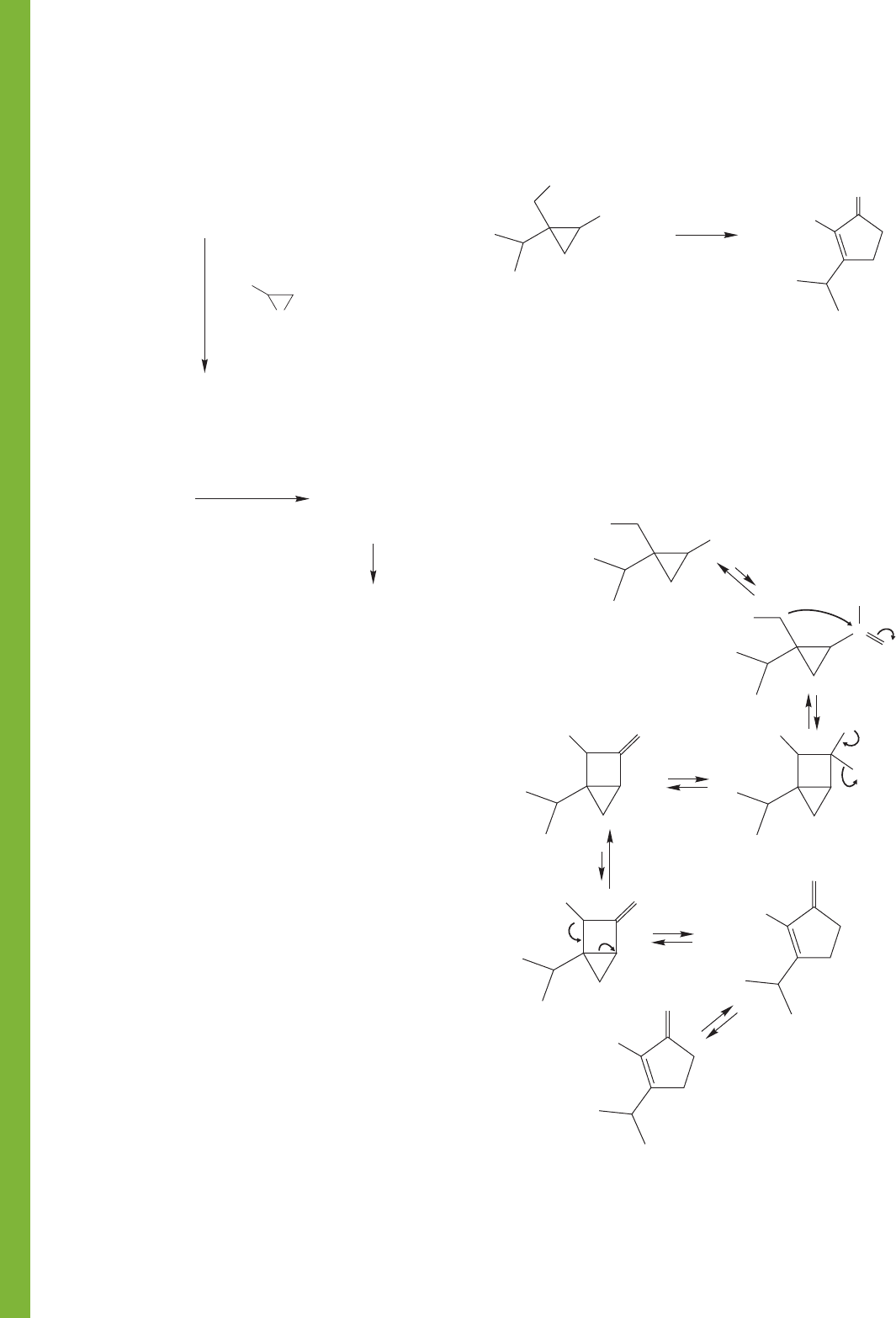
1024 CHAPTER 19 Carbonyl Chemistry 2: Reactions at the Position␣
COOCH
3
COOCH
3
H
3
COOC
NaOCH
3
HOCH
3
O
Compound E
Mass spectrum: m/z 162 (M, 100%), 106 (77%),
104 (51%), 43 (61%)
IR (melt): 1778 cm
1
(s)
1
H NMR (CDCl
3
): 2.1–2.15 (m, 1H), 2.5–2.7 (m, 3H),
5.45–5.55 (m, 1H), 7.2–7.4 (m, 5H)
13
C NMR (CDCl
3
): 28.9 (t), 30.9 (t), 81.2 (d), 125.2 (d),
128.4 (d), 128.7 (d), 139.3 (s), 176.9 (s)
Compound F
Mass spectrum: m/z 162 (M, 28%), 104 (100%)
IR (film): 1780 cm
1
(s)
1
H NMR (CDCl
3
): 2.67 (dd, J 17.5 Hz, 6.1 Hz, 1H),
2.93 (dd, J 17.5 Hz, 8.1 Hz, 1H), 3.80 (m, 1H),
4.28 (dd, J 9.0 Hz, 8.1 Hz), 4.67 (dd, J 9.0 Hz,
7.9 Hz, 1H), 7.22–7.41 (m, 5H)
13
C NMR (CDCl
3
): 35.4 (t), 40.8 (d), 73.8 (t), 126.5 (d),
127.4 (d), 128.9 (d), 139.2 (s), 176.3 (s)
PROBLEM 19.81 Provide an arrow formalism for the following
reaction:
–
–
–
–
..
..
..
CH
3
OOC
CH
3
OOC
COOCH
3
H
3
COOC
OCH
3
OCH
3
HOCH
3
C
O
O
H
3
COOC
NaOCH
3
O
H
3
COOC
O
H
3
COOC
O
O
H
3
COOC
CH
2
(COOCH
2
CH
3
)
2
A +
(each C
13
H
14
O
4
)
(each C
11
H
10
O
4
)
B
C + DA + B
1. CH
3
CH
2
ONa/CH
3
CH
2
OH
1. KOH/H
2
O
E + F
130–140 ⬚C
2. H
2
O/H
3
O
3. CH
3
COOH
2.
O
Ph
+
PROBLEM 19.80
Provide structures for compounds A–F.
Spectral data for compounds E and F are summarized
below.
PROBLEM 19.82 Here is an answer to Problem 19.81, which
appears in the original paper describing the reaction. Perhaps it
is the answer you came up with. First, criticize this proposal—
what makes it unlikely? Next, you can either feel good about
finding another mechanism already, or, if this was your answer,
set about finding a better mechanism. Hint: Find a way to
remove strain in the starting material.
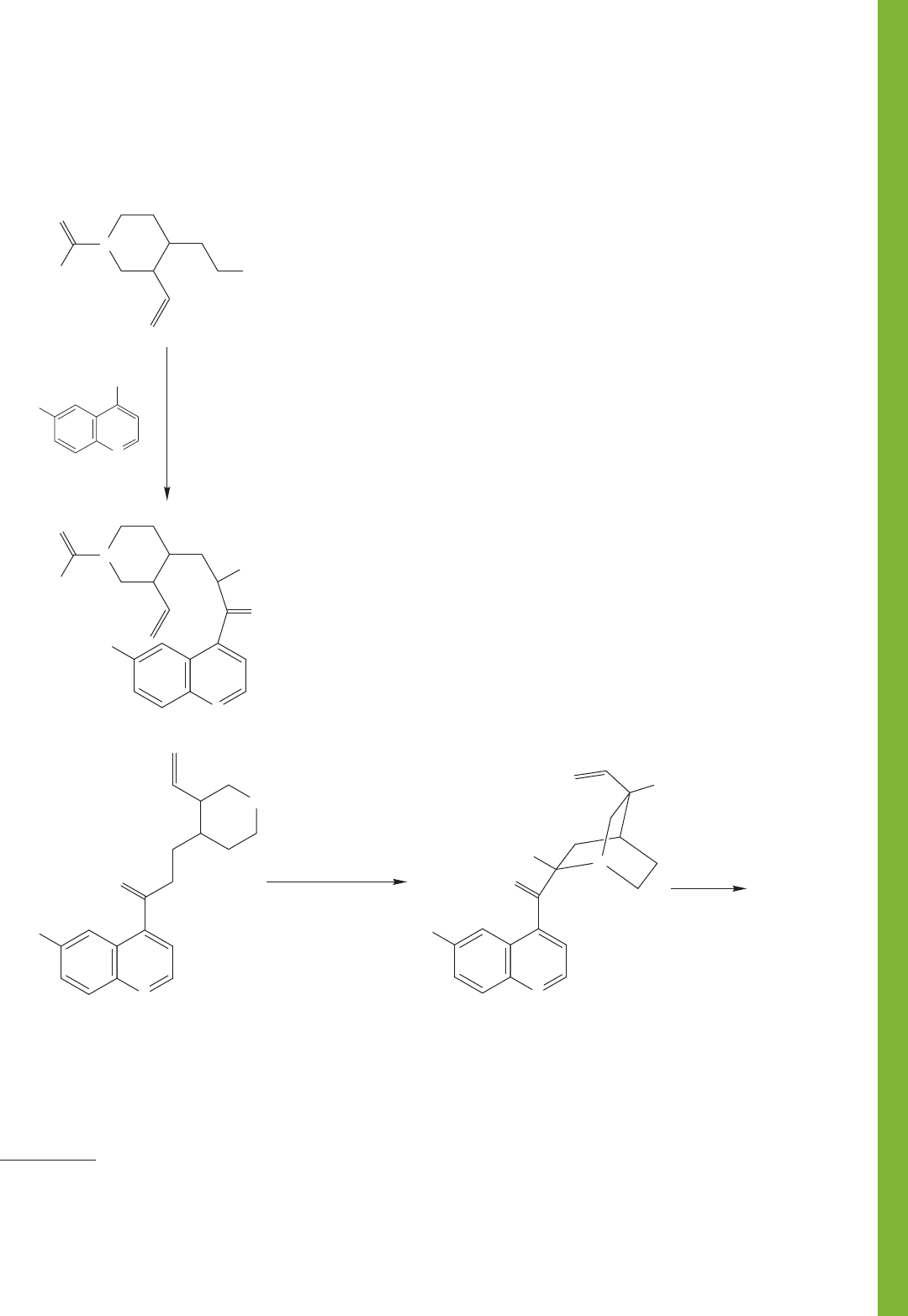
19.17 Additional Problems 1025
PROBLEM 19.83
Outline mechanisms for the following trans-
formations leading to quinine:
5
CH
3
O
N
COOEt
O
(a)
1. NaOEt/HOEt,
Δ
2. neutralize
Ph
N
COOEt
CH
3
O
N
O
Ph
N
COOEt
O
reduction
Quinine
H
CH
3
O
N
O
(b)
1. Br
2
, NaOH, H
2
O
2. NaOH, H
2
O
NH
CH
3
O
N
O
H
N
5
Named for the Countess of Chinchón, wife of a seventeenth century Peruvian viceroy, supposedly cured of
the vapors by use of the bark.
The structure of this complex molecule presents an extraordi-
nary synthetic challenge and was accomplished in the early
1940s by R. B. Woodward and William von E. Doering. It’s
worth a look at this synthesis. It was not only an achievement
of brilliance, but used many of the reactions whose mechanisms
we have studied.
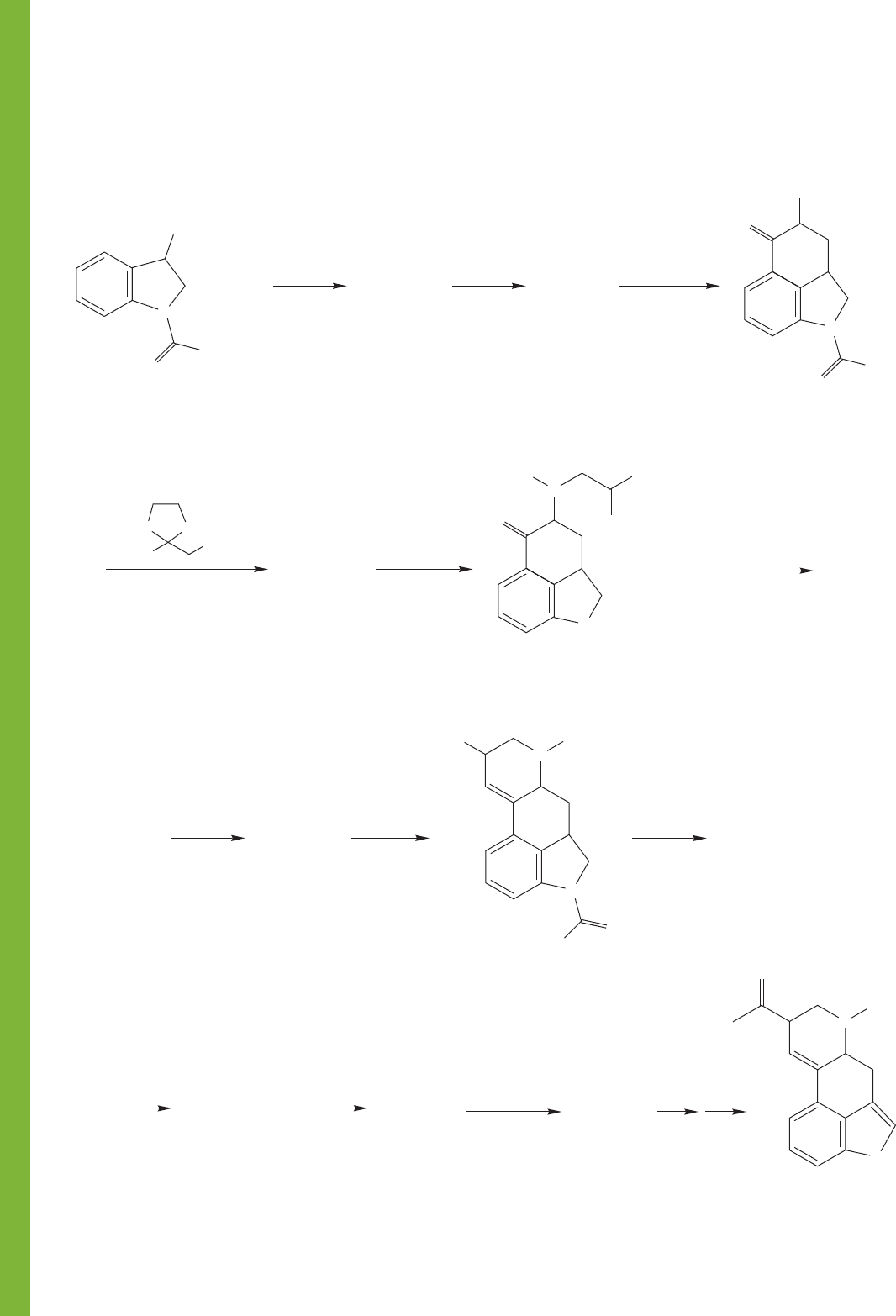
1026 CHAPTER 19 Carbonyl Chemistry 2: Reactions at the Position␣
N
(a)
(b)
A
Ph
O
Ph
O
CH
2
CH
2
COOH
(C
18
H
17
NO
3
)
SOCl
2
N
B
AlCl
3
D
1.
2. NaOH
H
2
O/H
3
O
+
C
(C
18
H
14
NO
2
Br)
C
Br
2
/HOAc
O
Br
O
O
F
(C
15
H
16
N
2
O)
NaOCH
3
/HOCH
3
(C
18
H
16
NO
2
Cl)
(C
24
H
26
N
2
O
4
)
(C
18
H
15
NO
2
)
H
3
C
NHCH
3
O
E
(C
15
H
18
N
2
O
2
)
NH
N
CH
3
H
3
C
O
(c)
(d)
FG
Ac
2
O
1. NaBH
4
2. H
2
O
O
H
3
C
N
H
(C
17
H
20
N
2
O
2
)
N
CH
3
HO
LSD
NH
N
CH
3
(C
15
H
16
N
2
O)
(C
17
H
18
N
2
O
2
)
I
SOCl
2
several steps
J
NaCN
CH
3
OH
H
2
O/H
2
SO
4
(C
17
H
19
N
2
OCl)
I
(C
18
H
19
N
3
O)
L
1. NaOH
2. H
3
O
+
/H
2
O
(C
16
H
18
N
2
O
2
)
K
(C
17
H
20
N
2
O
2
)
(CH
3
CH
2
)
2
N
O
PROBLEM 19.84 The reactions shown below were important
in the synthesis of LSD. Provide structures for the indicated
compounds.
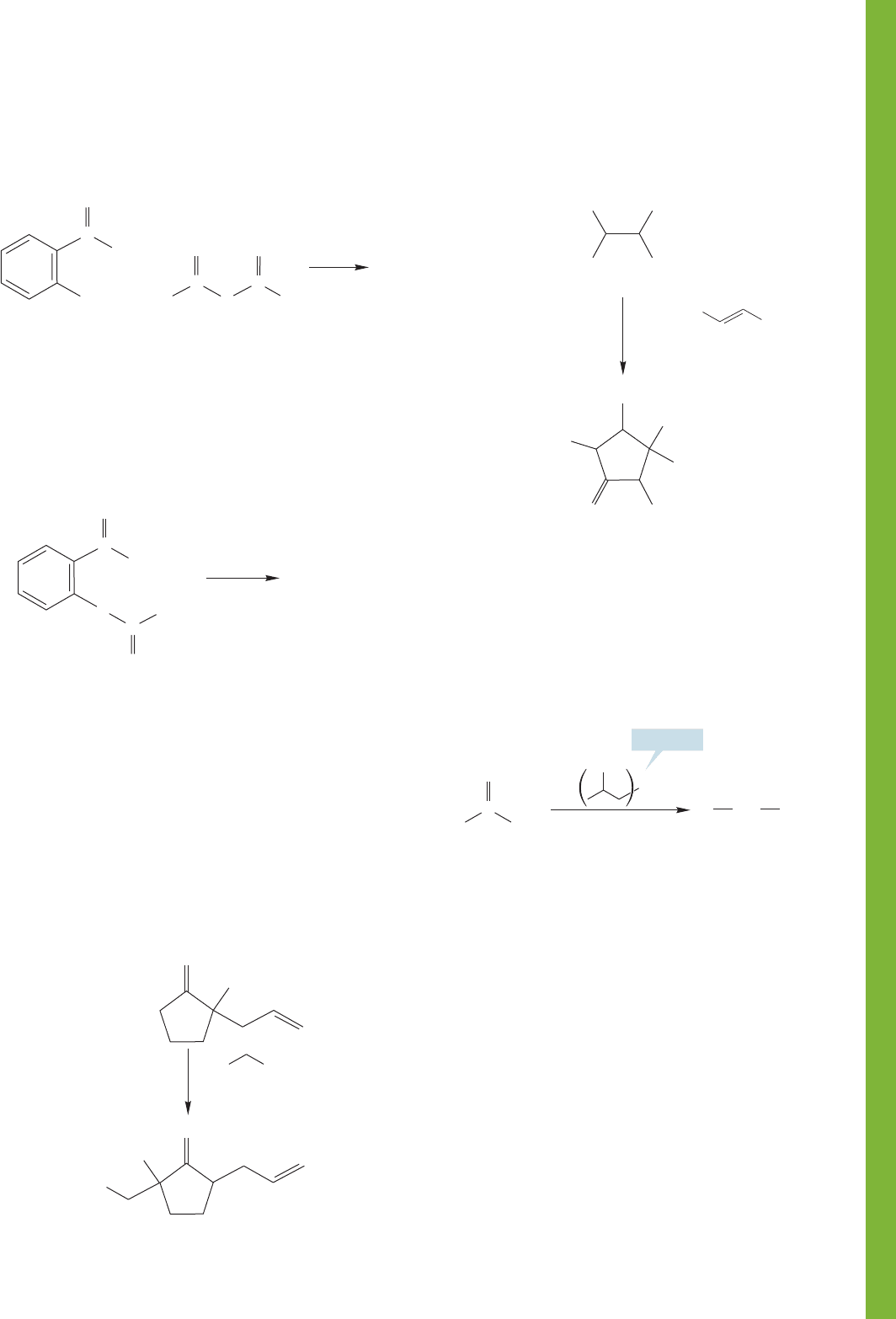
19.17 Additional Problems 1027
PROBLEM 19.85
Reaction of salicylaldehyde (1) and acetic
anhydride in the presence of sodium acetate gives compound 2,
a fragrant compound occurring in sweet clover.
PROBLEM 19.87 Provide an arrow formalism for the following
reaction:
+
O
OH
CH
3
H
3
C
C
H
1
2
C
O
O
NaOAc
O
C
Spectral data for compound 2 are collected below. Deduce
the structure of 2. Naturally, it is an interesting question as to
how 2 is formed. This problem turns out to be harder than it
looks at first. Nonetheless, you might want to try to formulate
a mechanism. However, note that O-acetylsalicylaldehyde
(3) gives only traces of 2 in the absence of acetic anhydride.
O
H
3
2
In low yield
C
C
O
O
CH
3
Compound 2
Mass spectrum: m/z 146 (M, 100%), 118 (80%), 90 (31%),
89 (26%)
IR (Nujol): 1704 cm
1
(s)
1
H NMR (CDCl
3
): δ 6.42 (d, J 9 Hz, 1H), 7.23–7.35
(m, 2H), 7.46–7.56 (m, 2H), 7.72 (d, J 9 Hz, 1H)
13
C NMR (CDCl
3
): δ 116.6 (d), 116.8 (d), 118.8 (s), 124.4 (d),
127.9 (d), 131.7 (d), 143.4 (d), 154.0 (s), 160.6 (s)
PROBLEM 19.86 Rationalize the following transformation.
Hint: See Problem 19.35a.
3. Br
O
COOCH
2
CH
3
, Δ
1. NaOCH
3
/CH
3
OH, Δ
2. remove CH
3
OH
H
3
COOC
O
CH
3
CH
2
OOC
COOCH
3
H
3
C
H
3
COOC
H
3
COOC
COOCH
3
1. NaOCH
3
/CH
3
OH, Δ
COOCH
3
3. CH
3
COOH
CH
3
COOCH
3
COOCH
3
Ph
Ph
2. H
3
COOC
O
PROBLEM 19.88 Diisobutylaluminum hydride (DIBAL-H),
like lithium aluminum hydride (LiAlH
4
) and sodium boro-
hydride (NaBH
4
), can reduce aldehydes and ketones to
alcohols.
2. H
2
O
C
RH
O
AlH
1.
DIBAL-H
2
OHRCH
2
Write a mechanism for this reaction. Interestingly, 1 mol
of DIBAL-H can reduce up to 3 mol of aldehyde despite
possessing only one apparent hydride equivalent.
Propose a mechanism that accounts for the second and
third equivalents of hydride in these aldehyde reductions.
Hint: Remember the Meerwein–Ponndorf–Verley–Oppenauer
equilibration.
PROBLEM 19.89 Provide structures for intermediates A–D
on the next page. A mechanistic analysis is not required for
this problem, but will almost certainly be of use in develop-
ing an answer. Hint: You will discover that there are certain
structural ambiguities in this problem. The following experi-
mental observation should prove helpful. Mild hydrolysis of
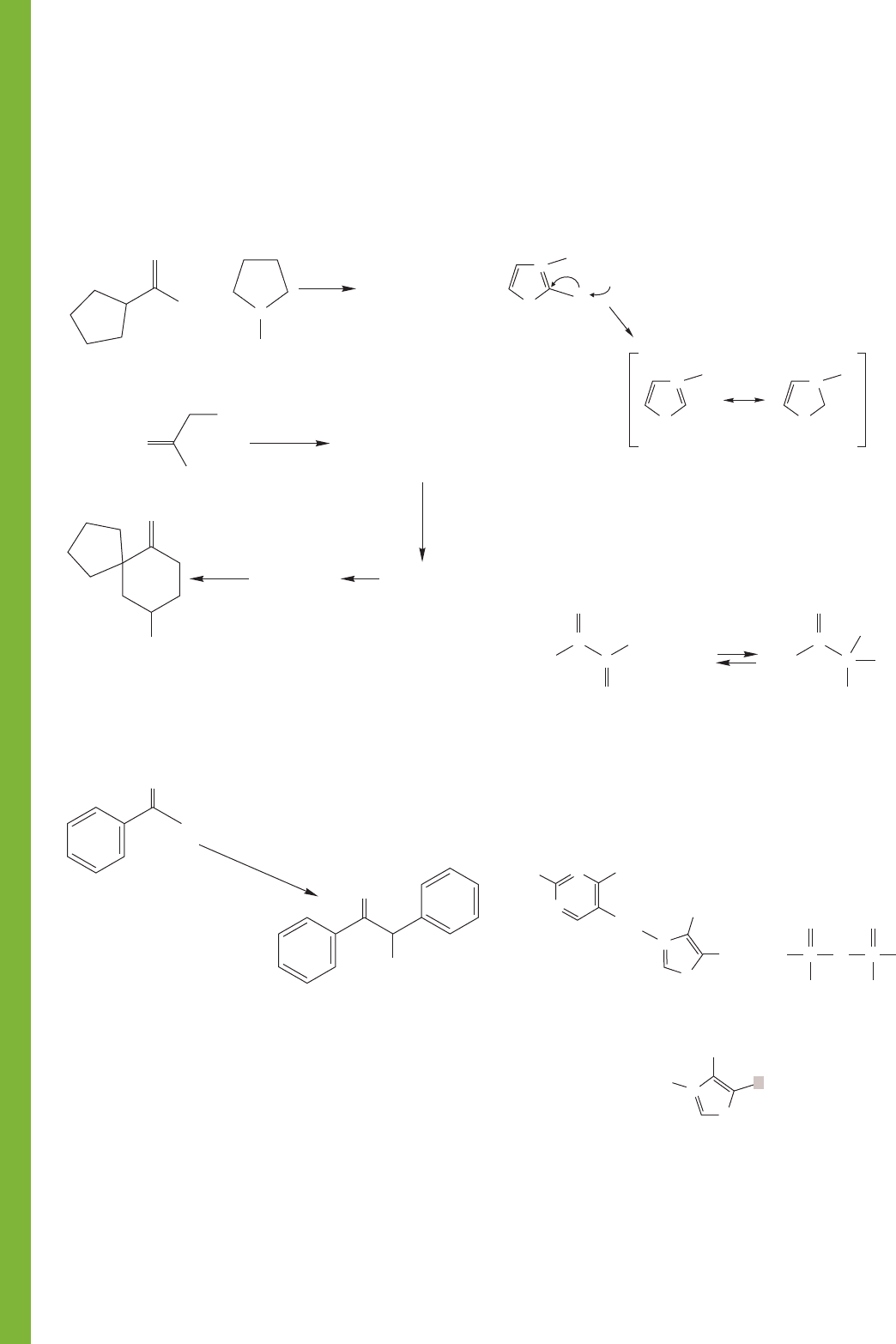
1028 CHAPTER 19 Carbonyl Chemistry 2: Reactions at the Position␣
O
CH
3
N
H
O
(C
11
H
19
N)
A
B
A
21
3
H
3
O
+
H
3
O
+
H
2
O
benzene
H
2
C
(C
16
H
26
NO
2
+
Br
–
)
C
(C
16
H
25
NO
2
)
D
(C
16
H
25
NO
2
)
4
(CH
3
CH
2
)
3
N
CH
3
CN, Δ
+
+
Br
COOCH
3
COOCH
3
O
H
O
OH
2. H
2
O/HCl
1. KCN/CH
3
OH
30 h, 65 ⬚C
Benzoin
(80%)
compound B affords compound E (C
12
H
18
O
3
), which is
characterized by the following spectra:
IR (CHCl
3
): 1715 cm
1
1
H NMR (CDCl
3
): δ 1.55–1.84 (m, 9H), 2.60 (s, 4H),
3.77 (s, 3H), 5.52 (br d, 1H), 6.08 (d, 1H)
PROBLEM 19.92 A few other catalysts will promote benzoin-
like condensations. Deprotonated thiazolium ions are examples.
Show how the compound shown can function like cyanide and
catalyze the benzoin condensation of pivaldehyde (tert-butyl-
carboxaldehyde).
PROBLEM 19.90 When treated with KCN in methyl alcohol,
benzaldehyde is converted into a molecule called benzoin. Write
a mechanism for this change.
Caution! This problem is hard. Do not succumb to the
temptation to remove that aldehydic proton—it is not acidic.
Something else must happen. Hints: What will the nucleophile
cyanide do to benzaldehyde? How does that reaction alter the
nature of the formerly “aldehydic” hydrogen?
PROBLEM 19.91 Show why hydroxide or ethoxide is ineffective
in promoting the benzoin condensation. Those anions do add
to the carbonyl group of benzaldehyde to form compounds
much like a cyanohydrin.
N
S
H
+
R
N
S
+
R
N
S
R
BH
+
B
..
..
..
..
–
–
Thiazolium
ion
Deprotonated thiazolium ion
PROBLEM 19.93 Acetolactate (2) is a precursor of the amino
acid valine in bacterial cells. Acetolactate is synthesized by the
condensation of two molecules of pyruvate (1).
–
CH
3
O
C“H
+
”+
+
O
H
3
C2
12
C
O
O
C COO
–
OH
H
3
C
CO
2
C
The enzyme that catalyzes this reaction (acetolactate syn-
thetase) requires thiamine pyrophosphate (TPP) as a coenzyme.
TPP
H
3
C
N
N
S
NH
2
CH
2
CH
2
CH
2
O
=
P
O
OH
OH
P
O
OH
+
CH
3
N
S
R
+
CH
3
N
R
O
Suggest a plausible mechanism for the synthesis of acetolactate
(
2). Hints: Review Problem 19.92. Note that this condensation
is accompanied by a decarboxylation (loss of CO
2
) that actually
precedes coupling. Finally, you may use the enzyme to do acid-
or base-catalyzed reactions as required.
